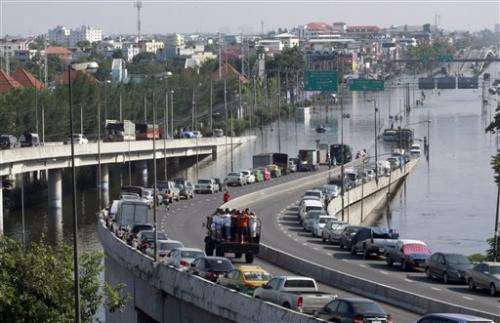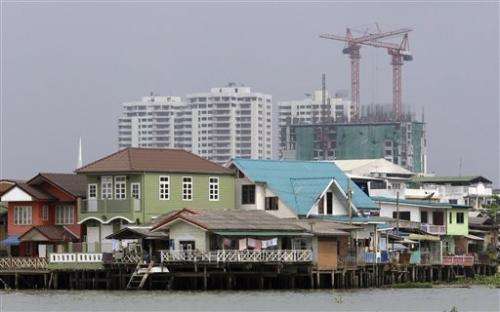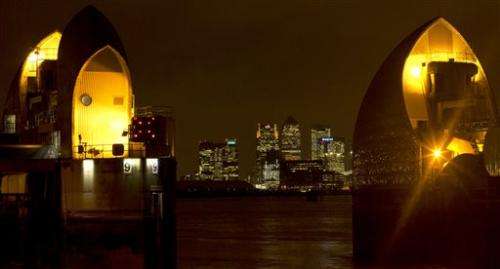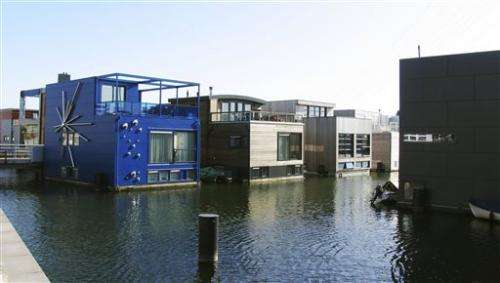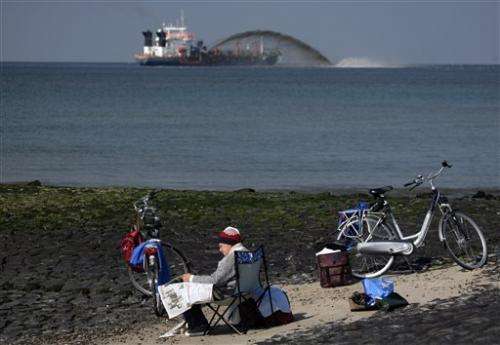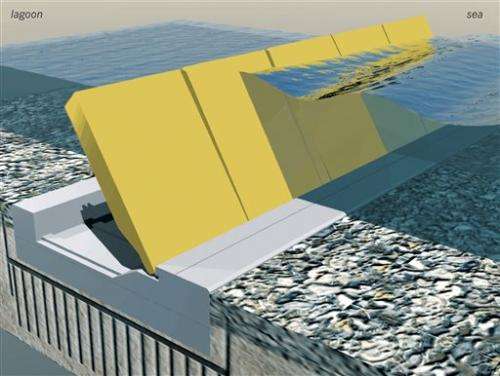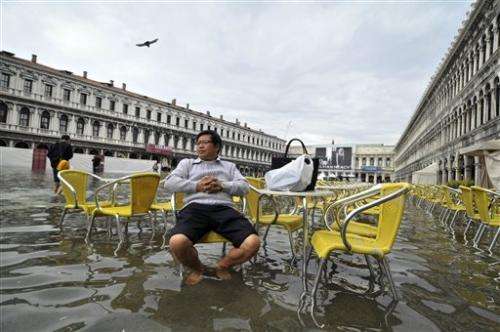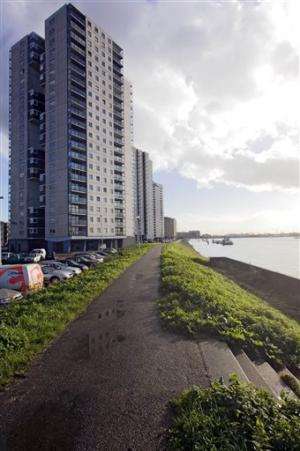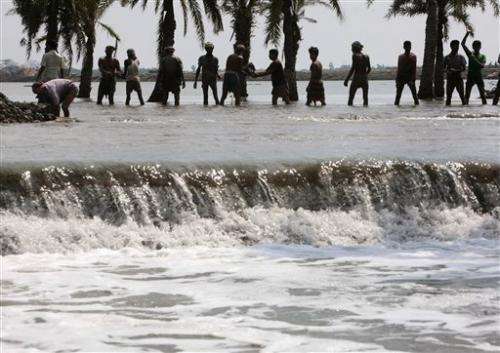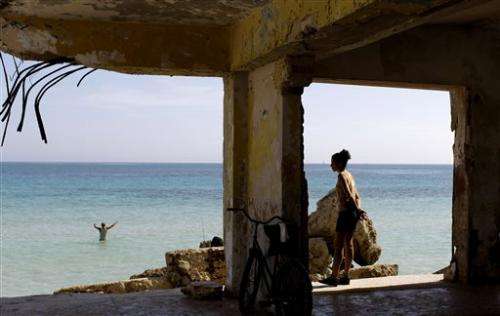In this Oct. 24, 2011 file photo, cars are parked on an overfly on a flooded street in Bangkok, Thailand. Sea level rise projections show Bangkok could be at risk of inundation in 100 years unless preventive measures are taken. But when the capital and its outskirts were affected in 2011 by the worst flooding in half-a century, the immediate trigger was water run-off from northern provinces, where dams failed to contain unusually heavy rains. (AP Photo/Apichart Weerawong, File)
From Bangkok to Miami, cities and coastal areas across the globe are already building or planning defenses to protect millions of people and key infrastructure from more powerful storm surges and other effects of global warming.
Some are planning cities that will simply adapt to more water.
But climate-proofing a city or coastline is expensive, as shown by New York Mayor Michael Bloomberg's $20 billion plan to build floodwalls, levees and other defenses against rising seas.
The most vulnerable places are those with the fewest resources to build such defenses, secure their water supplies or move people to higher ground. How to pay for such measures is a burning issue in U.N. climate talks, which just wrapped up a session in the German city of Bonn.
A sampling of cities around the world and what they are doing to prepare for the climatic forces that scientists say are being unleashed by global warming:
___
ROTTERDAM, Netherlands. In a country where two-thirds of the population lives below sea level, the battle against the sea has been a matter of life and death for centuries.
The Dutch government devotes roughly 1 percent of its annual budget to its intricate system of dikes, dunes and sea walls. Improvements to cope just with the effects of climate change have been carried out since 2003—though planning began well before that.
The focus in the 20th century was on a spectacular series of sea defenses, including massive steel and concrete barriers that can be quickly moved to protect against storm surges.
But current techniques embrace a philosophy of "living with water:" Floods are inevitable, and it's better to prepare for them than to build ever-higher dikes that may fail catastrophically.
In this March 26, 2012 file photo, residences on stilts sit along the Chao Phraya River with a construction site in the background in Bangkok, Thailand. Sea level rise projections show Bangkok could be at risk of inundation in 100 years unless preventive measures are taken. (AP Photo/Sakchai Lalit, File)
Thousands of waterways are being connected so the country can essentially act as one big sponge and absorb sudden influxes of water. Some areas have been designated as flood zones. Houses that can float have been a building sensation.
Along the coast, the country has been spouting huge amounts of sand in strategic locations offshore and allowing the natural motion of waves to strengthen defensive dunes.
____
VENICE, Italy. Sea level rise is a particular concern for this flood-prone city. It's in the process of realizing an expensive and oft-delayed system of underwater barriers that would be raised in the event of flooding over 43 inches (110 centimeters), higher than the 31-inch (80-centimeter) level that floods the famed St. Mark's Square.
Venice, a system of islands built into a shallow lagoon, is extremely vulnerable to rising seas because the sea floor is also sinking.
The constant flooding puts the city's considerable architectural treasures at risk. Venice has experienced 10 events over 4 feet 7 inches (140 centimeters) since 1950, including a devastating 1966 flood. Plans for the new so-called Moses barriers will cost more than 4 billion euros. The first of these have been moved into place in recent days. Many Venetians remain skeptical of the project due to the high costs and concerns over environmental risks.
___
LONDON. The low-lying capital of a perpetually soggy country, London has long been vulnerable to flooding—particularly when powerful storms send seawater racing up the River Thames.
The financial center of Canary Wharf just outside the boundary of the City of London is seen through the Thames Barrier at night on Friday, Dec. 28, 2012. The low-lying city has long been vulnerable to flooding - particularly when powerful storms send seawater racing up the River Thames. But the 570-yard-long (half-a-kilometer-long) barrier, composed of 10 massive steel gates, each five stories high when raised against high water, has been in operation since 1982. (AP Photo/Alastair Grant, File)
But Londoners already have a powerful flood defense: the 570-yard-long (half-a-kilometer-long) Thames Barrier, composed of 10 massive steel gates, each five stories high when raised against high water.
Some have called for Thames Barrier—in operation since 1982—to be replaced or supplemented by an even more ambitious flood defense system farther down the river. But Britain's Environment Agency says the defenses should hold until 2070.
Meanwhile, environmentally conscious Londoners have made plans to battle some of the other predicted effects of global warming by promoting better water management, expanding the city's Victorian sewage network, and "urban greening"—the planting of trees and rooftop gardens to help manage the urban heat island effect.
___
MIAMI. Southern Florida is one of those places that show up as partially under water in many sea level projections for this century. So it's no surprise local leaders are seeking ways to adapt. Four counties of South Florida, including Miami-Dade, have collaborated on a regional plan to respond to climate change. Their overarching goal: keeping fresh water inland and salt water away.
A gardener works in a show garden 'RBC Blue Water Roof Garden', designed by Nigel Dunnett and The Landscape Agency, during the Chelsea Flower Show in London on Monday, May 20, 2013. Environmentally conscious Londoners have made plans to battle some of the predicted effects of global warming by promoting better water management, expanding the city's Victorian sewage network, and "urban greening" - the process of planting trees and rooftop gardens to help managing the heat island effect common to urban areas. (AP Photo/Sang Tan, File)
The first action plan calls for more public transportation, stemming the flow of seawater into freshwater, and managing the region's unique ecosystems so they can adapt.
Before writing the plan, the counties reviewed regional sea level data and projected a rise of 9 to 24 inches (23 to 61 cm) in the next 50 years along a coastline that already has documented a rise of 9 inches over the last 100 years.
"The rate's doubled. It would be disingenuous and sloppy and irresponsible not to respond to it," said Monroe County Administrator Roman Gastesi, who oversees the Florida Keys.
___
NEW YORK CITY. Mayor Michael Bloomberg last week announced one of the most ambitious plans for defending a major U.S. city from climate change. Recommendations range from installing removable flood walls in lower Manhattan to restoring marshes in Jamaica Bay in Queens, and from flood-proofing homes to setting repair timeframe standards for phone and Internet service providers.
In this Wednesday, March 28, 2012 file photo, amphibious homes float on the harbor in the IJburg neighborhood in Amsterdam. IJburg is a new district in the eastern part of town completely surrounded by water. The Netherlands, a third of which lies below sea level, has been managing water since the Middle Ages. (AP Photo/Margriet Faber)
In lower Manhattan, a removable system of posts and slats could be deployed to form temporary flood walls. The height would depend on the ground elevation and potential surge. The approach is used along some Midwestern rivers and in the Netherlands, city officials said.
Projects also include a 15-to-20-foot levee to guard part of Staten Island, building dunes in the Rockaways, building barrier systems of levees and gates to bar one creek from carrying floodwaters inland, and possibly creating a levee and a sizeable new "Seaport City" development in lower Manhattan.
___
BANGLADESH. A low-lying delta nation of 153 million people, Bangladesh is one of Asia's poorest countries, and one that faces extreme risks from rising sea levels. Its capital, Dhaka, is at the top of a list of world cities deemed most vulnerable to climate change, according to a recent survey by risk analysis company Maplecroft. The World Bank says a sea level rise of 5 inches (14 centimeters) would affect 20 million people living along the country's 440-mile (710-kilometer) coast. Many of these people would be homeless.
In this Thursday, Sept. 18, 2008 file photo, a woman reads a newspaper as a ship sprays sand and gravel for a "sand supplementation" off the coast near Petten, Netherlands. Sand supplementation is a technique where sand is poured on or near the coast, and natural water currents push it into place to strengthen dikes or dunes. (AP Photo/Peter Dejong, File)
Bangladesh is implementing two major projects worth $470 million that involve growing forests on the coastal belt and building more multistory shelters to house people after cyclones and tidal surges. Developed nations have so far provided $170 million to the fund.
"Bangladesh is opting for adapting to the climate change impacts as the world's developed nations are not doing enough to cut down carbon emissions," said Forest and Environment Minister Hasan Mahmud in a recent speech in Dhaka. "We want the donors to contribute more to our efforts."
___
MALDIVES. The Maldives, an upmarket beach paradise for tourists, has also become a symbol of the dangers of climate change.
This rendering made available by the New Venice Consortium on Dec. 5, 2008, shows the moveable barriers that will be used to prevent severe flooding in Venice, Italy. The project is named "Moses," after the Old Testament figure who parted the Red Sea. Many Venetians remain skeptical of the project due to the high costs and concerns over environmental risks. (AP Photo/Graziano Arici/New Venice Consortium)
Made up of hundreds of islands in the Indian Ocean, it's one of the most low-lying nations in the world, and exceptionally vulnerable to rising seas.
Some scientists have said the Maldives could disappear within decades, and former President Mohamed Nasheed even proposed relocating all 350,000 inhabitants to other countries.
A tourist sits outside a cafe in a flooded St. Mark square as high tides reached 1.05 meters above sea level, partly flooding the city of Venice, Italy on Monday, Oct. 15, 2012. The Lagoon City, a system of islands built into a river delta, is extremely vulnerable to rising sea levels. At the same time it is experiencing a lowering of the sea floor. The constant flooding puts the city's considerable architectural treasures at risk. (AP Photo/Luigi Costantini)
While other researchers say those fears may have been overblown, the country is taking measures to protect itself.
A seawall was built around the capital, Male, after flooding in the 1980s. That wall protected the city from the worst effects of the devastating 2004 tsunami, which temporarily put large swaths of the country under water.
In this Saturday, Oct. 8, 2005 file photo, boats sail in Miami's Biscayne Bay at the start of the annual Columbus Day Regatta. Southern Florida is one of the places that shows up as partially under water in many sea level projections for the 21st century. (AP Photo/Lynne Sladky, File)
The country's climate adaptation plans call for relocating residents from small vulnerable islands to bigger, better protected ones.
It's also creating new land through land reclamation, expanding existing islands or building new ones, to ease overcrowding. The reclaimed land is being elevated to better withstand rising seas.
___
BANGKOK, Thailand. Even before the consequences of climate change became evident, scientists were well aware that Bangkok—whose southern suburbs border the Gulf of Thailand—was under serious threat from land subsidence.
Sea level rise projections show Bangkok could be at risk of inundation in 100 years unless preventive measures are taken. But when the capital and its outskirts were affected in 2011 by the worst flooding in half a century, the immediate trigger was water runoff from the north, where dams failed to hold very heavy rains.
This Wednesday, Nov. 16, 2005 file photo shows apartment buildings built just behind a small dike which separates them from the Maas River in Rotterdam, The Netherlands. Current techniques to deal with climate change embrace a philosophy summarized as "living with water." It says floods are inevitable, and it's better to prepare for them than to build ever-higher dikes that may eventually fail catastrophically. (AP Photo/Fred Ernst, File)
Industrial areas in the capital's suburbs, housing important businesses, were devastated. So the focus was put on a short-term solution for that area.
The government recently announced winning bids totaling 290.9 billion baht ($9.38 million) by Chinese, South Korean and Thai firms to run the flood and water management schemes, including the construction of reservoirs, floodways and barriers.
In this Sunday, May 31, 2009 file photo, floodwaters flow to a lower area as villagers rebuild an embankment at Protap Nagar in Shatkhira, Bangladesh, about 176 kilometers (109 miles) southwest of Dhaka after Cyclone Aila. The low-lying delta nation of 153 million people is one of Asia's poorest countries, and one that faces extreme risks from rising sea levels. (AP Photo/Pavel Rahman, File)
Solutions to the problem of rising seas are still being studied.
"Construction alone is not sustainable," says Seree Supratid, director of a climate and disaster center at Rangsit University. "People have to adapt to nature. For example, you know Bangkok will be flooded by the rising seas in the next 100 years, then you have to learn to build your houses in a way the floodwater cannot reach it, putting it up high or something."
___
CUBA. Officials recently finished a study of the effects of climate change on this island's 3,500 miles (5,630 kilometers) of coastline, and their discoveries were so alarming they didn't immediately share the results with the public to avoid causing panic.
According to the report, which The Associated Press obtained exclusively, rising sea levels would seriously damage 122 Cuban towns or even wipe them off the map by 2100. Scientists found that miles of beaches would be submerged while freshwater sources would be tainted and croplands rendered infertile. In all, seawater would penetrate up to 1.2 miles (2 kilometers) inland in low-lying areas, as oceans rose nearly 3 feet (85 centimeters).
In this May 23, 2013 file photo, a woman stands in what remains of a destroyed school as she watches a fisherman on the shores of Havana, Cuba. With its coastal towns and cities, the Caribbean is one of the most vulnerable regions to a changing climate. (AP Photo/Franklin Reyes)
Those frightening calculations have spurred systemic action in Cuba, the largest island in the Caribbean and one that is heavily dependent on beach-loving European and Canadian tourists. In recent months, inspectors and demolition crews have begun fanning out across the island with plans to raze thousands of houses, restaurants, hotels and improvised docks in a race to restore much of the coast to something approaching its natural state.
In the tourist resort of Varadero, the country faces a dilemma: Tearing down seaside restaurants and hotels threatens millions of dollars in yearly tourism revenue, while allowing them to stay puts at risk the very beaches that are the main draw.
___
MBEERE, Kenya. While sea level rise threatens some coastal communities in Africa, the continent faces even bigger climate-related problems inland. Climate scientists have projected shifts in rainfall patterns leading to extended droughts in some areas and increased flooding in other parts. To small-scale farming communities, these shifts could be disastrous, adding further stress to scarce water supplies.
Adaptation therefore is focused on learning to cope with the climatic changes, adjusting farming practices and improving water conservation efforts.
In Kenya's Mbeere district, where people say they're noticing longer dry spells, U.K.-based charity group Christian Aid is teaching farmers to help them predict the seasons and know better what to grow and when to plant.
In this Monday, Aug. 17, 2009 file photo, children salvage the remains of a failed potato field at a farm in the Laikipia District, of Kenya, some 200 kilometers (120 miles) north of the capital Nairobi, in the wake of a prolonged drought which wiped out harvests throughout the country. While sea level rise threatens some coastal communities in Africa, the continent faces even bigger climate-related problems inland. Climate scientists have projected shifts in rainfall patterns leading to extended droughts in some areas and increased flooding in other parts. (AP Photo/Khalil Senosi, File)
A text messaging system helps farmers get up-to-date weather reports specific to their locations.
"We are supporting them to access and interpret climate information and help them make forward-looking decisions so that their farming is better suited to the predicted changing conditions," said Mohamed Adow, of Christian Aid. "Farmers live off the land and the weather, and small changes to weather patterns can be a big disaster to small-scale farmers in Africa whose entire livelihoods and well-being depend on farming."
© 2013 The Associated Press. All rights reserved.
